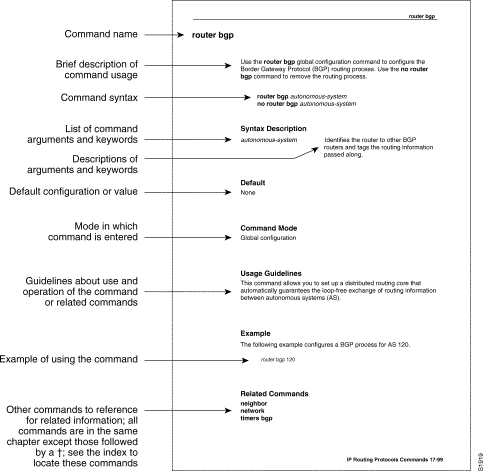This section discusses the objectives, audience, organization, and conventions of the Access and Communication Servers Command Reference publication.
All Cisco technical documentation and additional literature are available UniverCD', Cisco's online library of product information. UniverCD is updated and shipped monthly, so it might be more up to date than printed documentation. UniverCD is available both as a single CD and as an annual subscription. To order UniverCD, contact your local sales representative or call Customer Service.
This publication provides an in-depth description of the commands necessary for configuring and maintaining your access server. It describes tasks only in the context of using a particular command; it does not describe how the tasks interrelate or provide comprehensive configuration examples. It can be used as a standalone reference manual or in conjunction with the Access and Communication Servers Configuration Guide.
See the Cisco Access Connection Guide for information about making connections to access servers.
This publication is intended as a standalone document for experienced users who will be configuring and maintaining their access server and just need to reference commands. For less-experienced users who need to understand the tasks as well as the commands, it is intended as a companion guide to the Access and Communication Servers Configuration Guide.
This publication is divided into seven main parts and appendixes. Each part comprises chapters describing related tasks or functions. The organization of parts and chapters in this publication matches the organization of parts and chapters in the Access and Communication Servers Configuration Guide, except that this document contains appendixes. The parts in this publication are as follows:
- Part 1, "Product Introduction," provides an overview of access server functionality and hardware configuration options, and introduces you to the access server user interface.
- Part 2, "System and Interface Configuration and Management," describes commands used to perform basic system and interface configuration, monitoring, and management tasks.
- Part 3, "Wide-Area Networking," describes commands used to configure dial-on-demand routing (DDR), X.25, SMDS, and Frame Relay WAN software.
- Part 4, "Terminal Services," describes commands used to configure your access server for terminal connections and terminal services, including Telnet, LAT, and TN3270.
- Part 5, "Telecommuting Services," describes commands used to configure your access server to support telecommuting services, including ARA, SLIP, PPP, and XRemote.
- Part 6, "Routing Services," describes commands used to configure and manage the AppleTalk, IP and IPX protocols for routing.
- Part 7, "Protocol Translation," describes commands used to configure your access server to support protocol translation.
- "Appendixes" contains five appendixes including the ASCII character set, modem support and chat scripts, regular expressions, a list of references and recommended reading, and X.3 PAD parameters.
Software and hardware documentation uses the following conventions:
- The symbol ^ represents the key labeled Control.
- For example, the key combination ^D means hold down the Control key while you press the
D key.
- A string is defined as a nonquoted set of characters. For example, when setting up a community string for SNMP to "public," do not use quotes around the string, or the string will include the quotation marks.
Command descriptions use these conventions:
- Commands and keywords are in boldface font.
- Arguments for which you supply values are in italic font.
- Elements in square brackets ([ ]) are optional.
- Alternative but required keywords are grouped in braces ({ }) and separated by vertical bars (|).
Examples use these conventions:
- Examples that contain system prompts denote interactive sessions, indicating that the user enters commands at the prompt. The system prompt indicates the current command mode. For example, the prompt
router(config)# indicates global configuration mode.
- Terminal sessions and information the system displays are in
screen font.
- Information you enter is in
boldface screen font.
- Nonprinting characters, such as passwords, are in angle brackets (< >).
- Default responses to system prompts are in square brackets ([ ]).
- Exclamation points (!) at the beginning of a line indicate a comment line.
 | Caution Means reader be careful. You are capable of doing something that might result in equipment damage or loss of data. |
Note Means
reader take note. Notes contain helpful suggestions or references to materials not contained in this manual.
The following illustration explains the fields on a typical command reference page:



